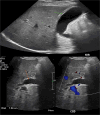Neuroendocrine carcinoma causing common bile duct obstruction: a case report
- PMID: 40162142
- PMCID: PMC11952893
- DOI: 10.1093/omcr/omaf011
Neuroendocrine carcinoma causing common bile duct obstruction: a case report
Abstract
A 46-year-old male with no comorbidities was referred to our hospital because of jaundice and elevated LFT markers. After further investigations, he underwent magnetic resonance cholangiopancreatography (MRCP), which revealed a hypo-enhancing periampullary mass measuring 15 mm in size causing common bile duct (CBD) dilatation of 12 mm in cross diameter with intrahepatic biliary obstruction, which explained the patient's symptoms. Side-view endoscopy was performed to obtain a specimen of the mass. Further histopathological workup revealed poorly differentiated neuroendocrine carcinoma (NEC). A multidisciplinary team (MDT) was conducted, and the patient was planned to undergo positron emission tomography-computed tomography (PET-CT) scan to investigate any further organ metastasis. Unfortunately, the patient missed his upcoming appointments and was lost to follow-up. Nevertheless, more research is needed to understand pathogenesis and the best course of management for small periampullary NETs.
Keywords: common bile duct obstruction; jaundice; periampullary carcinoma; periampullary neoplasms.
© The Author(s) 2025. Published by Oxford University Press.
Conflict of interest statement
No conflicts of interest.
Figures





References
Publication types
LinkOut - more resources
Full Text Sources

